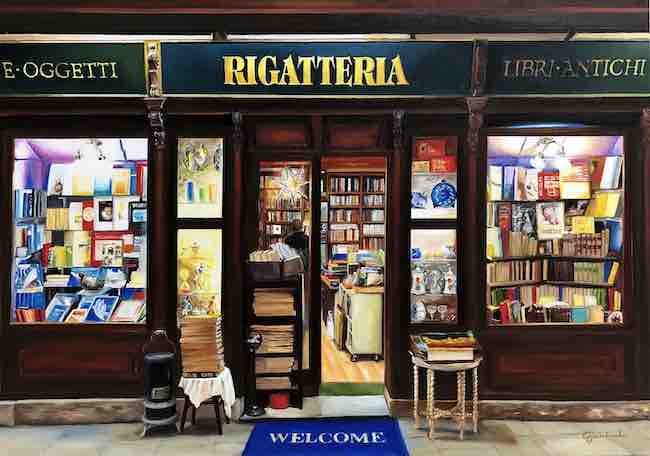La tendenza contemporanea a servirsi delle immagini come strumento per mostrarsi, per rappresentare quella patina lucente che è necessario mostrare al mondo esterno, induce spesso gli individui a tralasciare ciò che si nasconde oltre le righe, al di là di una facciata perfetta che induce a dimenticare l’essenza; il ruolo dell’artista è proprio quello di andare oltre, di focalizzare la propria attenzione, e di conseguenza quella dell’osservatore, sulla profondità intensa che emerge da un ascolto più attento e sensibile verso tutto ciò che ruota intorno. In particolar modo uno stile molto vicino alla realtà osservata può far pensare a un distacco dalle emozioni, a una eccessiva attenzione alla perfezione formale a discapito delle sensazioni; l’artista di cui vi racconterò oggi, al contrario, pur mostrando un forte talento rappresentativo, riesce a infondere atmosfera alle sue opere che si trasformano in vere e proprie narrazioni emozionali.
Quando cominciò a fuoriuscire da parte degli artisti del Diciannovesimo secolo un’inconsueta necessità di andare oltre i soggetti fino a poco prima parte della produzione dei loro predecessori, dediti prevalentemente al ritratto di personaggi della nobiltà, dell’aristocrazia oppure di immagini religiose commissionate dalle stesse chiese, si iniziò a generare una trasformazione sia dal punto di vista stilistico, seppur ancora legato alle regole pittoriche accademiche, sia dal punto di vista della libertà espressiva, quella necessità di introdurre in alcuni casi persino una narrazione più sottile rispetto a quella semplicemente vista con gli occhi, che contraddistinse i più coraggiosi rappresentanti dell’arte di quel periodo. Il Romanticismo Inglese, in particolar modo quello di William Turner, sottolineò l’esistenza di una forza superiore all’essere umano, quella natura potente e travolgente contro cui l’uomo non poteva combattere, focalizzando l’attenzione verso l’inspiegabile che veniva percepito dal soggetto osservante, nel caso specifico l’artista, che fino a poco prima era stata lasciata in disparte. Tuttavia il Realismo, l’altro grande movimento dell’Ottocento, sembrava ancora rincorrere l’importanza della conformità assoluta a tutto ciò che gli occhi vedevano inducendo gli artisti aderenti a voler rinunciare a mettere se stessi all’interno delle tele; eppure i soggetti immortalati stavano comunque cambiando, l’attenzione si era spostata dalla nobiltà alle persone meno abbienti, al popolo con la sua vita quotidiana dura e precaria, aggiungendo pertanto in qualche modo un’accezione sociale alle tele. Con il trascorrere degli anni questi due movimenti persero via via terreno per lasciare spazio alle avanguardie, alle correnti più innovative che investirono la fine del Diciannovesimo e la prima metà del Ventesimo secolo, dove la realtà fu lasciata da parte per esplorare l’indefinitezza, il valore dell’atto plastico fine a se stesso, l’introduzione del mondo dell’inconscio, degli incubi, la scomposizione scientifica dell’immagine, e via dicendo fino a giungere a un momento in cui vi fu la necessità di ritrovare anche il contatto con la realtà osservata. Realtà che però, forte delle esperienze artistiche degli anni precedenti, introdusse in qualche modo l’emozione, le sensazioni esistenziali, come nel Realismo Americano di Edward Hopper e di Norman Rockwell oppure al contrario, se ne distaccò completamente focalizzandosi su un approccio quasi fotografico, sebbene in alcuni casi metafisico, come nell’Iperrealismo di Ralph Goings e Richard Estes. L’artista di origini siciliane ma da anni residente in Friuli Giulia Crimaldi fonde lo stile iperrealista allo sguardo romantico nei confronti della realtà, come se attraverso il filtro del suo punto di vista le immagini cominciassero spontaneamente a raccontare storie più sottili rispetto a quanto osservabile; almeno per quanto riguarda una parte della sua produzione pittorica, quella nella quale rende protagonisti spaccati di vita, negozi e librerie, all’interno dei quali si svolgono scene quotidiane eppure straordinarie nel loro fascino, come se non solo i personaggi ma gli scaffali e le pareti stesse volessero raccontare tutta la vita che nel corso degli anni è passata sotto il loro sguardo.
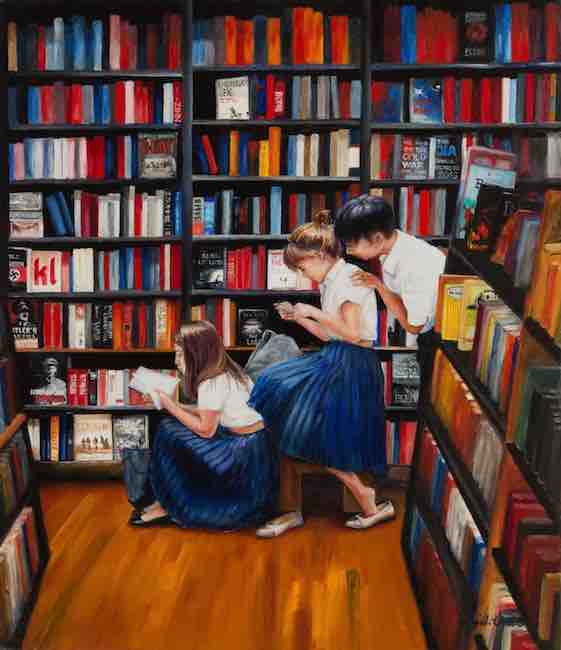
Questa serie di tele ricordano, nell’atmosfera, quelle di Norman Rockwell per le ambientazioni senza tempo, spaccati di esistenza di un mondo in cui tutto è semplice, piacevole, quasi magico nella sua spontaneità, allo stesso modo in cui il maestro statunitense narrava delle serene giornate trascorse nella provincia americana dove tutto profumava di buono, nonostante i lontani echi della guerra; nei dipinti di Giulia Crimaldi c’è maggiore contemporaneità, più vicinanza ai tempi attuali, eppure si respira la medesima aria sospesa, come se le sue opere fossero collocate in un tempo diverso, parallelo, in cui tutto ciò che fa parte del presente si incontra con la storia più recente, quel saper essere ancora puri, quel sapersi mantenere semplici che non può che essere insegnamento per le generazioni di oggi.
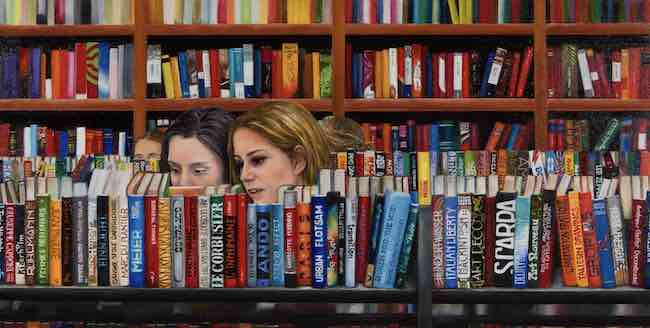
I libri sono un patrimonio importante, sembra suggerire l’artista, è lì che è scritta la storia, quella che non è palesata o raccontata a scuola bensì che si evince dalle affascinanti trame dei romanzi, che non giudica bensì semplicemente illustra le avventure e le colloca in un contesto storico in grado di lasciar fuoriuscire molto di più che la sola trama; è questo che emerge dall’opera Paper style dove le due ragazze protagoniste sono concentrate sulla scelta della storia da leggere, si stanno lasciando avvincere dal soggetto dentro cui poi si caleranno, una volta che avranno deciso di acquistare il volume. L’approccio di Giulia Crimaldi è quello di chi osserva con discrezione le emozioni e le sensazioni che i suoi personaggi vivono, come se fosse lei stessa l’autrice di racconti per immagini che hanno la caratteristica di catturare immediatamente l’attenzione e la curiosità del fruitore.
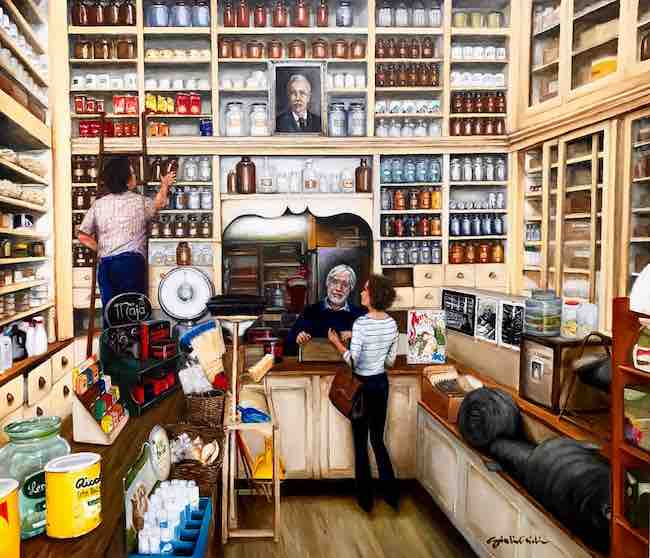
In Drogheria Toso la donna di spalle, perfettamente calata nei tempi moderni, ama frequentare un vecchio negozio, di quelli in cui il proprietario è gentile e accogliente, allo stesso modo di come aveva forse accolto la nonna tanto tempo prima, quando magari lei stessa bambina si lasciava incuriosire dai tanti barattoli e sperava in una caramella donata dal paterno signore al bancone. La scena profuma di storie familiari, di ricordi, di innumerevoli persone aiutate, di merci vendute, quasi come se quel negozio fosse una parte della grande famiglia della comunità del quartiere, come se il proprietario fosse un padre buono pronto a correre in soccorso di chiunque ne avesse bisogno.
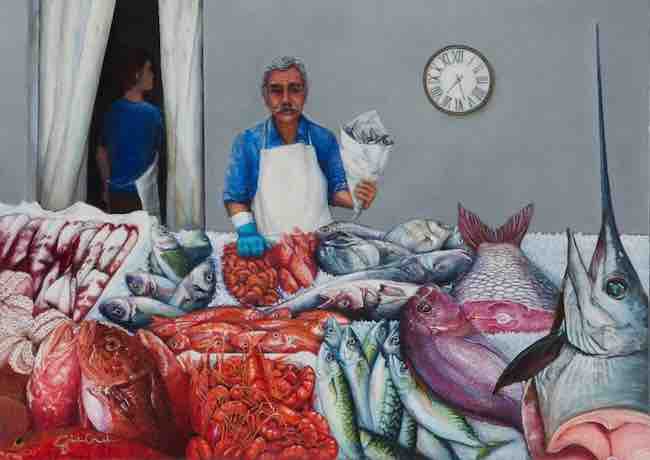
Allo stesso modo l’opera Via Faro 95 racconta di una pescheria, di quelle in cui il pesce viene ancora avvolto nella carta oleata, di quelle in cui l’odore forte spinge la mente a immaginare la freschezza del mare, il sapore del pescato notturno che poco dopo giunge sul banco per essere venduto. Questa tela introduce il tema di un’altra delle serie pittoriche di Giulia Crimaldi, quella dei pesci ai quali, con lo stesso approccio iperrealista ma romantico, dà nomi umani, come se ciascuno dei suoi protagonisti acquatici fosse associato alla caratteristica di una persona o di un personaggio famoso, umanizzando un mondo sotterraneo che diviene metafora del continuo scorrere della realtà, di quel fluire eracliteo di cui proprio i silenziosi e trascurati pesci possono diventare esempio di adattamento e di resilienza.
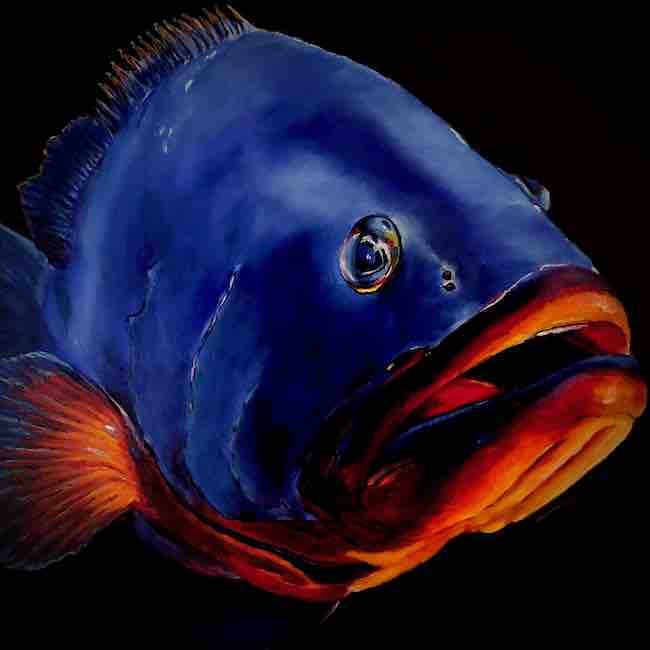
La sua incredibile capacità di riproduzione figurativa le permette di produrre opere in 3D in cui i colori accrescono la suggestione generata dallo sfondo nero che ne esalta le tonalità, quasi a evidenziare ancor più il buio dell’abisso marino a cui loro, la vita, danno vivacità con il costante movimento, con quello spostarsi e lasciarsi trasportare dalle onde senza opporvisi bensì semplicemente adattandosi.
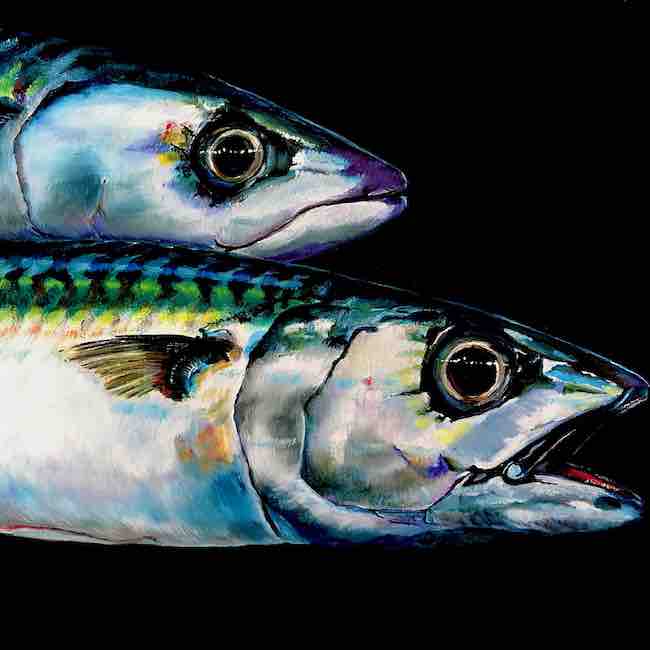
E poi tutta la sua mediterraneità esce e si palesa nella serie dei Fichi d’India, in cui riproduce il verde vivido e la freschezza di una pianta tipica della sua regione d’origine, la Sicilia, che non può che evocare il sole e il mare; e infatti i Pesci insieme ai Fichi d’India sono entrati a far parte del nuovo progetto di Giulia Crimaldi, quello di creare una linea di abbigliamento dove le immagini delle sue opere si materializzano su kimono, abiti e teli mare, un progetto che sta già riscuotendo un ottimo riscontro.
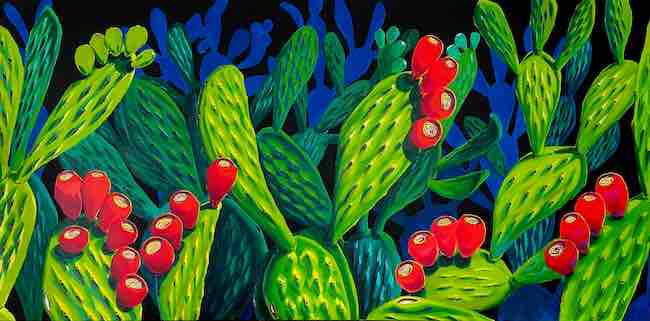
Dopo aver frequentato per diversi anni la bottega di due grandi maestri, Ivano e Gabriele Bonato, e altri corsi di perfezionamento della tecnica a olio e acrilico su tela, Giulia Crimaldi ha effettuato un interessante percorso espositivo sia nell’ambito di mostre collettive che con esposizioni personali a Parigi, Saint Moritz e Palermo oltre che un’antologica a Trieste, riscuotendo ampi consensi da parte del pubblico e della critica.
GIULIA CRIMALDI-CONTATTI
Email: giulia.crimaldi@gmail.com
Sito web: http://www.giuliacrimaldi.it
Facebook: https://www.facebook.com/profile.php?id=100009086504471
Instagram: https://www.instagram.com/giulia_crimaldi/
Stories of the present and evocations of the past in Giulia Crimaldi’s Romantic Hyperrealism
The contemporary tendency to use images as a tool to show oneself, to represent that glossy patina that one needs to show to the outside world, often induces individuals to overlook what is hidden behind the lines, beyond a perfect façade that induces to forget the essence; the artist’s role is precisely that of going beyond, of focusing one’s own attention, and consequently that of the observer, on the intense depth that emerges from a more attentive and sensitive listening to all that revolves around. In particular, a style that is very close to the observed reality can make think of a detachment from emotions, of an excessive attention to formal perfection to the detriment of sensations; the artist I am going to tell you about today, on the contrary, while displaying a strong representational talent, succeeds in infusing her artworks with atmosphere, transforming them into true emotional narratives.
When began to emerge an unusual need in 19th century artists to go beyond the subjects that had until recently been part of the production of their predecessors, who were predominantly devoted to portraits of the nobility, the aristocracy or religious images commissioned by the churches themselves, a transformation began to take place both from a stylistic point of view, although still bound to the academic pictorial rules, and from the point of view of expressive freedom, that need to introduce in some cases even a more subtle narrative than that simply seen with the eyes, which distinguished the most courageous representatives of art of that period. English Romanticism, especially that of William Turner, emphasised the existence of a force superior to the human being, that powerful and overwhelming nature against which man could not fight, focusing attention on the inexplicable that was perceived by the observing subject, in this case the artist, who until recently had been left in the background. However, Realism, the other great movement of the 19th century, still seemed to chase the importance of absolute conformity to everything the eyes could see, inducing the adhering artists to want to renounce putting themselves inside the canvases; yet the subjects immortalised were changing anyway, the focus had shifted from the nobility to the less affluent, to the people with their hard and precarious daily lives, thus somehow adding a social meaning to the canvases.
As the years went by, these two movements gradually lost ground to make way for the avant-garde, the most innovative currents that swept through the late 19th century and the first half of the 20th century, where reality was left aside to explore indefiniteness, the value of the plastic act as an end in itself, the introduction of the world of the unconscious, of nightmares, the scientific decomposition of the image, and so on, until reaching a moment when there was a need to also rediscover contact with the reality observed. Reality that, however, on the strength of the artistic experiences of the previous years, somehow introduced emotion, existential sensations, as in the American Realism of Edward Hopper and Norman Rockwell, or on the contrary, broke away from it completely, focusing on an almost photographic approach, although in some cases metaphysical, as in the Hyperrealism of Ralph Goings and Richard Estes. The artist, who is originally from Sicily but has lived in Friuli for many years, Giulia Crimaldi fuses the hyperrealist style with a romantic gaze towards reality, as if through the filter of her point of view the images spontaneously began to tell subtler stories than are observable; at least as far as a part of her pictorial production is concerned, the one in which she depicts slices of life, shops and bookshops, within which everyday scenes take place that are nevertheless extraordinary in their charm, as if not only the characters but the shelves and walls themselves wanted to tell the whole story of the life that has passed under their gaze over the years.
This series of canvases are reminiscent, in their atmosphere, of Norman Rockwell’s timeless settings, glimpses of the existence of a world in which everything is simple, pleasant, almost magical in its spontaneity, in the same way that the American master recounted the serene days spent in provincial America where everything smelled good, despite the distant echoes of the war; in Giulia Crimaldi’s paintings there is more contemporaneity, more closeness to current times, yet one breathes the same suspended air, as if her works were placed in a different, parallel time, in which everything that is part of the present meets with more recent history, that knowing how to still be pure, that knowing how to keep oneself simple that can only be a lesson for today’s generations. Books are an important heritage, the artist seems to suggest, it is there that history is written, the history that is not manifested or told in school but rather that can be inferred from the fascinating plots of novels, that does not judge but simply illustrates adventures and places them in a historical context that can allow much more to emerge than just the plot; this is what emerges from the artwork Paper style where the two protagonist girls are focused on choosing the story to read, they are letting themselves be captivated by the topic into which they will then immerse themselves, once they have decided to buy the volume. Giulia Crimaldi’s approach is that of someone who discreetly observes the emotions and sensations experienced by her characters, as if she herself were the author of tales in images that have the characteristic of immediately capturing the reader’s attention and curiosity. In Toso Drugstore, the woman from behind, perfectly in tune with modern times, likes to frequent an old shop, one in which the owner is kind and welcoming, in the same way as he had perhaps welcomed her grandmother long ago, when she herself as a child was maybe intrigued by the many jars and hoped for a candy donated by the fatherly gentleman at the counter.
The scene smells of family stories, of memories, of countless people helped, of goods sold, almost as if that shop were a part of the big family of the neighbourhood community, as if the owner were a good father ready to come to the rescue of anyone in need. Similarly, the painting Via Faro 95 tells of a fishmonger’s shop, one in which the fish is still wrapped in greaseproof paper, one in which the strong smell urges the mind to imagine the freshness of the sea, the flavour of the night catch that shortly after arrives on the counter to be sold. This canvas introduces the theme of another of Giulia Crimaldi’s pictorial series, that of the fish to which, with the same hyper-realist yet romantic approach, she gives human names, as if each of her aquatic protagonists were associated with the characteristic of a famous person or character, humanising an underworld that becomes a metaphor for the continuous flow of reality, of that Heraclitean flow of which the silent and neglected fish themselves can become an example of adaptation and resilience. Her incredible capacity for figurative reproduction allows her to produce 3D paintindgs in which the colours increase the suggestion generated by the black background that enhances the tones, almost as if to highlight even more the darkness of the marine abyss to which they, the life, give vivacity with their constant movement, with that moving and letting themselves be transported by the waves without opposing them but simply adapting. And then all her Mediterranean character comes out and reveals itself in the series of Prickly Pears, in which she reproduces the vivid green and freshness of a plant typical of her home region, Sicily, which cannot but evoke the sun and the sea; and indeed the Fishes together with the Prickly Pears have become part of Giulia Crimaldi’s new project, that of creating a clothing line where the images of her artworks materialise on kimonos, dresses and beach towels, a project that is already proving very popular. After having attended the workshop of two great masters, Ivano and Gabriele Bonato, for several years, and other courses in oil and acrylic on canvas technique, Giulia Crimaldi has made an interesting exhibition path both in the context of group exhibitions and with solo shows in Paris, Saint Moritz and Palermo as well as an anthological exhibition in Trieste, gaining wide acclaim from the public and critics.


